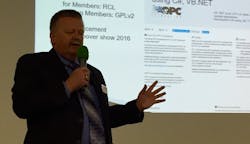Industrial Communication Organizations Embrace the Cloud
It’s not hard to spot a trend when it’s all that anyone’s talking about. And though the cloud has been a trending technology in industrial automation for several years, the full embrace of it by all the major suppliers and communication organizations serves only to underscore its increasing importance.
At Hannover Messe 2016, both OPC Foundation and ODVA announced new agreements, partnerships and commitments addressing the use of cloud services and technologies across industry.
The largest set of announcements was made by OPC Foundation, which included agreements related to Microsoft, SAP, Industrial Data Space, W3C, Open Fog Consortium, IO-Link, CC-Link, Association for Automatic Identification and Mobility, and CAN in Automation (CiA).
The most far-reaching of these announcements was the Microsoft announcement, in which the company noted it is working with the OPC Foundation to “enable virtually any industrial Internet of Things (IoT) scenario through interoperability between the millions of applications and industrial equipment compliant with the OPC UA standard.”
Microsoft explained that this extended support for the OPC UA open source software stack spans its IoT offerings, from local connectivity with Windows devices to cloud connectivity via the Microsoft Azure platform. Integration with Azure IoT allows users to send OPC UA telemetry data to the Azure cloud, as well as to command and control OPC UA devices remotely from the Azure cloud (read more about the “command and control” capability in my report on Microsoft’s display at Hannover Messe 2016). In addition, Windows 10 devices running the Universal Windows Platform can connect and openly communicate with other IoT devices via OPC UA.
"OPC UA is the single, neutral, widely accepted standard to embrace the complex world of automation devices to easily and securely connect them everywhere," said Stefan Hoppe, OPC Foundation vice president. "With the adoption by Microsoft to its Windows 10 operating system and Azure cloud, the OPC UA standard passes the critical milestone of general acceptance by the broader IT world."
Summarizing the other OPC announcements made at Hannover Messe 2016:
- SAP extends its existing commitments with OPC UA to include SAP’s HANA cloud platform as part of the company’s aim of connecting customers’ ERP order entry data into the manufacturing processes to update each step of the process from planning and preparation through the execution stages of production and into post-production data analysis,” said Veronika Schmid-Lutz of SAP.
- Dr. Reinhold Achatz, chief technology officer at ThyssenKrupp and chairman of the Industrial Data Space (IDS) Foundation announced that IDS and OPC Foundation have agreed to recognize each other and the complementary nature of their standards and move forward with development of an OPC UA connector for IDS. Achatz said a major driver of this agreement between the two organizations is the need for “a standard that defines secure exchange of data between clouds.”
- Dave Raggett of W3C (founded by Tim Berners-Lee) said the W3C wants to see integration of devices and systems from the shop floor to the office and across the supply chain while also dealing with security and trust issues. “There are many different platforms and standards that need to be integrated for this to happen,” he said, and that’s why W3C and OPC are working together to build on W3C’s strengths in semantic technologies (metadata across domains) and enabling application of services.
- Matt Vasey of Microsoft announced that the Open Fog Consortium is working to create a reference architecture to support intelligence from the cloud to edge devices. “We will define how to distribute computing, network storage, control and resources between the cloud and things,” he said. “OPC and Open Fog will collaborate on interoperability and distributed computing approaches to accelerate the digital factory transformation” through cooperation on standards and testbed research.
- Representatives from CC-Link, IO-Link, CiA, and the Association for Automatic Identification and Mobility all also announced agreements to work with OPC UA to map their associated protocols and/or technologies with OPC UA to bring industrial data to the cloud.
Meanwhile, ODVA announced that it is forming a special interest group focused on the development of a common industrial cloud interface for CIP-enabled industrial control. The resulting standard will “be a first of its kind industry standard for an industrial cloud interface and paves the way for vendors of cloud centric technologies to join with ODVA to collaborate on defining this standard,” said Katherine Voss, president and executive director of ODVA.
Voss added that the standard, which could be ready (at the earliest) near the end of 2018, would not address what happens to data once it’s in the cloud. Specifically, the interface will:
- Optimize the inter- and intra-premise exchange of data based on requirements of the control system, device(s) and data;
- Simplify workflows for configuration of data collected and exchanged with the cloud;
- Support firmware management of devices;
- Support identity discovery of devices; and
- Use secure identity management and communications technologies and standards such as HTTPS, MQTT and CIP Security.
As a result, the scope of the SIG’s work on this interface will focus on the gateway and the application programming interface (API). The gateway will map, aggregate and exchange CIP data between the cloud and the industrial device via EtherNet/IP and/or DeviceNet. The API will handle the secure transport of data (including but not limited to CIP) to and from the cloud and industrial applications.

